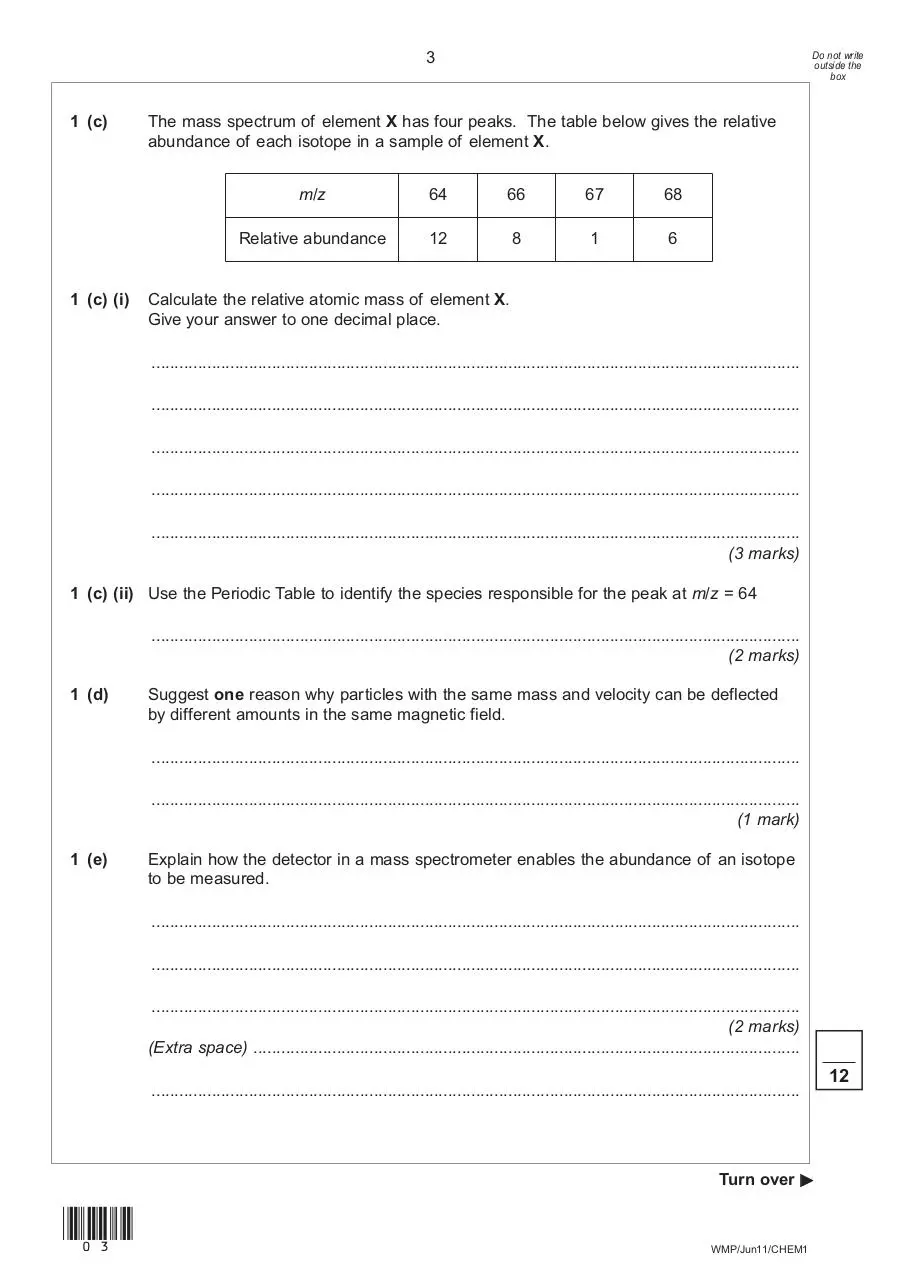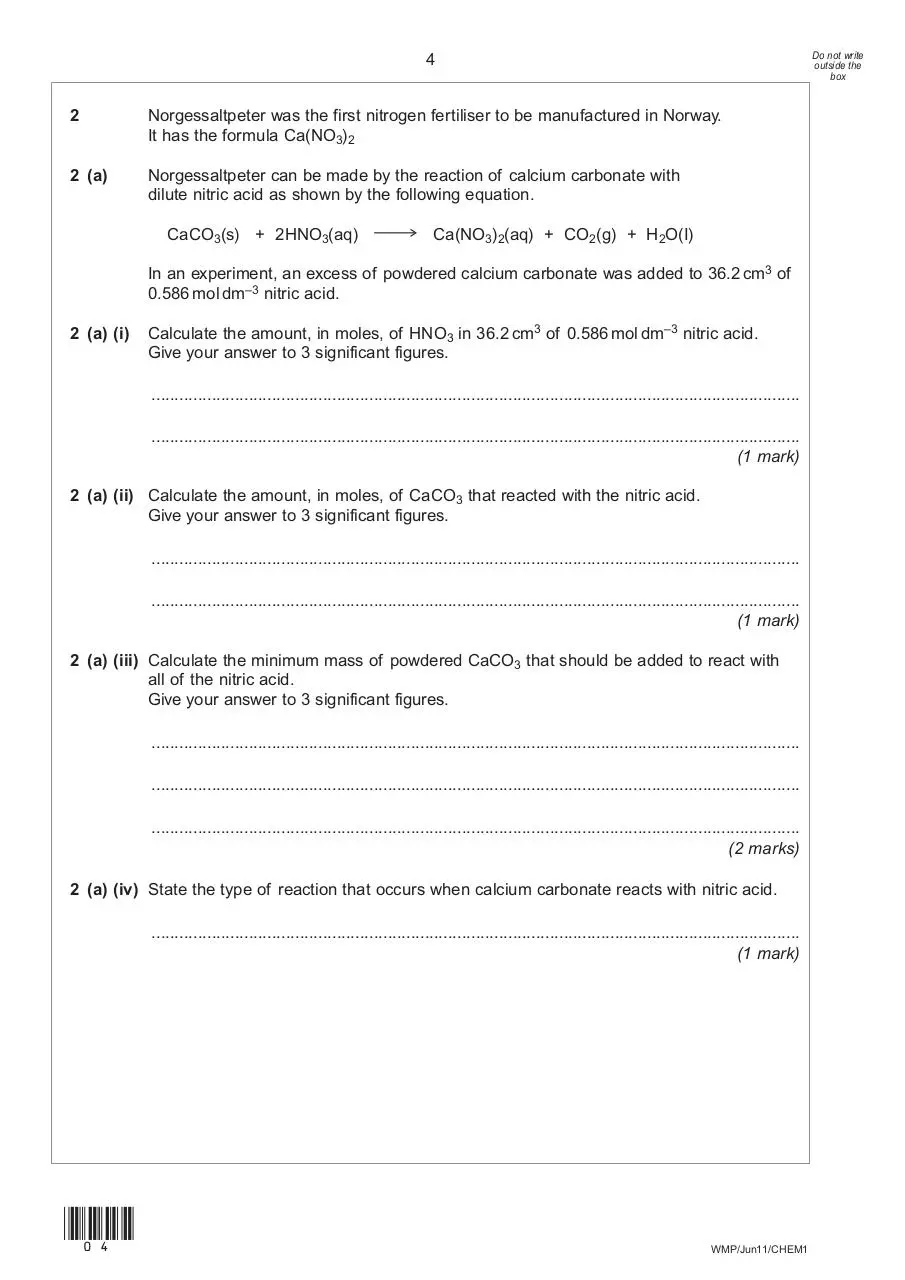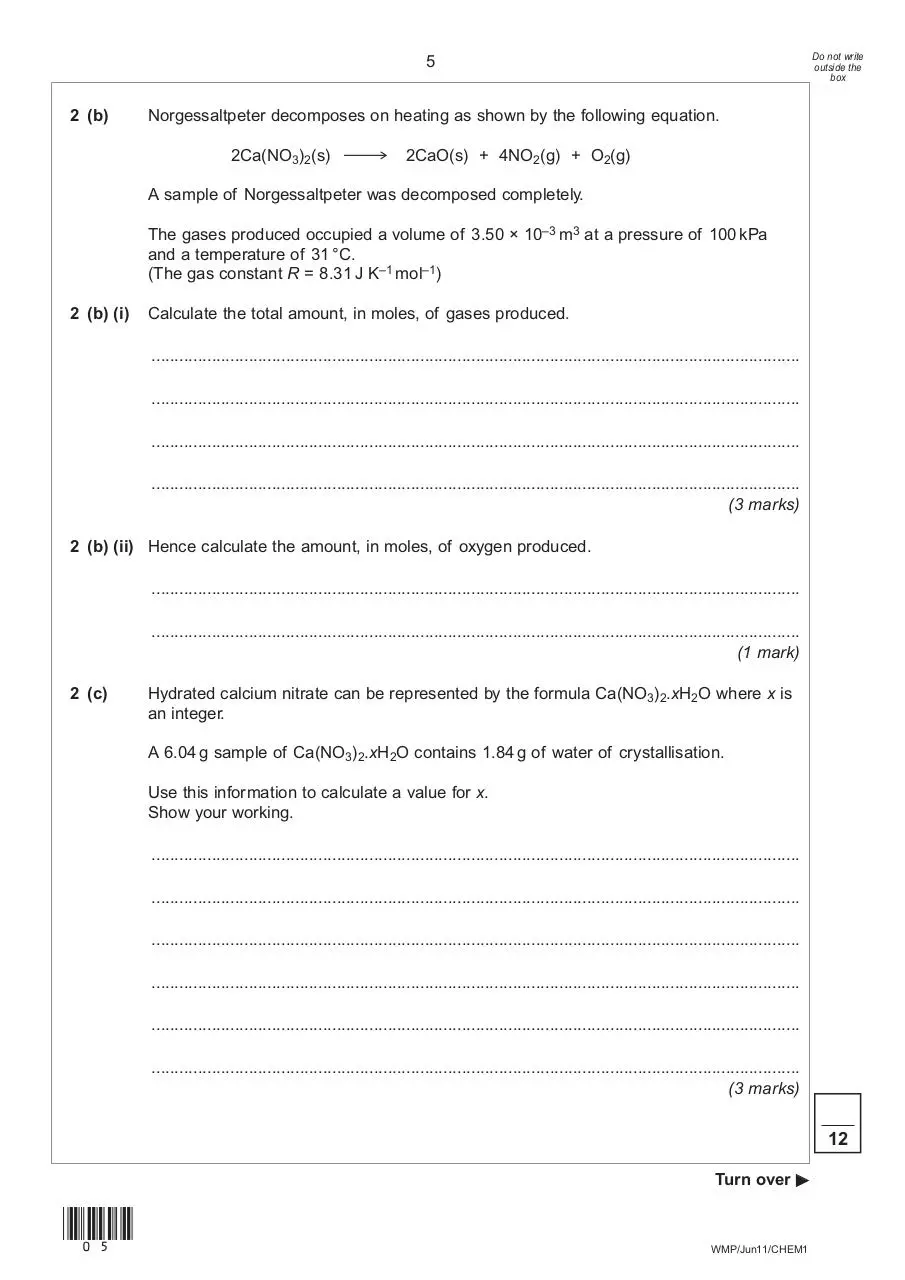Jun 11 (PDF)
File information
This PDF 1.6 document has been generated by , and has been sent on pdf-archive.com on 28/02/2017 at 16:06, from IP address 81.108.x.x.
The current document download page has been viewed 400 times.
File size: 2.24 MB (84 pages).
Privacy: public file





File preview
Centre Number
For Examiner’s Use
Candidate Number
Surname
Other Names
Examiner’s Initials
Candidate Signature
Question
General Certificate of Education
Advanced Subsidiary Examination
June 2011
Mark
1
2
3
Chemistry
Unit 1
CHEM1
5
Foundation Chemistry
Monday 23 May 2011
4
6
1.30 pm to 2.45 pm
7
For this paper you must have:
l the Periodic Table/Data Sheet, provided as an insert
(enclosed)
l a calculator.
TOTAL
Time allowed
l 1 hour 15 minutes
Instructions
l Use black ink or black ball-point pen.
l Fill in the boxes at the top of this page.
l Answer all questions.
l You must answer the questions in the spaces provided. Do not write
outside the box around each page or on blank pages.
l All working must be shown.
l Do all rough work in this book. Cross through any work you do not
want to be marked.
Information
l The marks for questions are shown in brackets.
l The maximum mark for this paper is 70.
l The Periodic Table/Data Sheet is provided as an insert.
l Your answers to the questions in Section B should be written in
continuous prose, where appropriate.
l You will be marked on your ability to:
– use good English
– organise information clearly
– use accurate scientific terminology.
Advice
l You are advised to spend about 50 minutes on Section A and about
25 minutes on Section B.
(JUN11CHEM101)
WMP/Jun11/CHEM1
CHEM1
Do not write
outside the
box
2
Section A
Answer all questions in the spaces provided.
1
Mass spectrometry can be used to identify isotopes of elements.
1 (a) (i)
In terms of fundamental particles, state the difference between isotopes of an element.
............................................................................................................................................
............................................................................................................................................
(1 mark)
1 (a) (ii) State why isotopes of an element have the same chemical properties.
............................................................................................................................................
............................................................................................................................................
(1 mark)
1 (b)
Give the meaning of the term relative atomic mass.
............................................................................................................................................
............................................................................................................................................
............................................................................................................................................
(2 marks)
(Extra space).......................................................................................................................
............................................................................................................................................
(02)
WMP/Jun11/CHEM1
Do not write
outside the
box
3
1 (c)
1 (c) (i)
The mass spectrum of element X has four peaks. The table below gives the relative
abundance of each isotope in a sample of element X.
m/z
64
66
67
68
Relative abundance
12
8
1
6
Calculate the relative atomic mass of element X.
Give your answer to one decimal place.
............................................................................................................................................
............................................................................................................................................
............................................................................................................................................
............................................................................................................................................
............................................................................................................................................
(3 marks)
1 (c) (ii) Use the Periodic Table to identify the species responsible for the peak at m/z = 64
............................................................................................................................................
(2 marks)
1 (d)
Suggest one reason why particles with the same mass and velocity can be deflected
by different amounts in the same magnetic field.
............................................................................................................................................
............................................................................................................................................
(1 mark)
1 (e)
Explain how the detector in a mass spectrometer enables the abundance of an isotope
to be measured.
............................................................................................................................................
............................................................................................................................................
............................................................................................................................................
(2 marks)
(Extra space) ......................................................................................................................
12
............................................................................................................................................
Turn over
(03)
䊳
WMP/Jun11/CHEM1
Do not write
outside the
box
4
2
Norgessaltpeter was the first nitrogen fertiliser to be manufactured in Norway.
It has the formula Ca(NO3)2
2 (a)
Norgessaltpeter can be made by the reaction of calcium carbonate with
dilute nitric acid as shown by the following equation.
CaCO3(s) + 2HNO3(aq)
Ca(NO3)2(aq) + CO2(g) + H2O(I)
In an experiment, an excess of powdered calcium carbonate was added to 36.2 cm3 of
0.586 mol dm–3 nitric acid.
2 (a) (i)
Calculate the amount, in moles, of HNO3 in 36.2 cm3 of 0.586 mol dm–3 nitric acid.
Give your answer to 3 significant figures.
............................................................................................................................................
............................................................................................................................................
(1 mark)
2 (a) (ii) Calculate the amount, in moles, of CaCO3 that reacted with the nitric acid.
Give your answer to 3 significant figures.
............................................................................................................................................
............................................................................................................................................
(1 mark)
2 (a) (iii) Calculate the minimum mass of powdered CaCO3 that should be added to react with
all of the nitric acid.
Give your answer to 3 significant figures.
............................................................................................................................................
............................................................................................................................................
............................................................................................................................................
(2 marks)
2 (a) (iv) State the type of reaction that occurs when calcium carbonate reacts with nitric acid.
............................................................................................................................................
(1 mark)
(04)
WMP/Jun11/CHEM1
Do not write
outside the
box
5
2 (b)
Norgessaltpeter decomposes on heating as shown by the following equation.
2Ca(NO3)2(s)
2CaO(s) + 4NO2(g) + O2(g)
A sample of Norgessaltpeter was decomposed completely.
The gases produced occupied a volume of 3.50 × 10–3 m3 at a pressure of 100 kPa
and a temperature of 31 °C.
(The gas constant R = 8.31 J K–1 mol–1)
2 (b) (i)
Calculate the total amount, in moles, of gases produced.
............................................................................................................................................
............................................................................................................................................
............................................................................................................................................
............................................................................................................................................
(3 marks)
2 (b) (ii) Hence calculate the amount, in moles, of oxygen produced.
............................................................................................................................................
............................................................................................................................................
(1 mark)
2 (c)
Hydrated calcium nitrate can be represented by the formula Ca(NO3)2.xH2O where x is
an integer.
A 6.04 g sample of Ca(NO3)2.xH2O contains 1.84 g of water of crystallisation.
Use this information to calculate a value for x.
Show your working.
............................................................................................................................................
............................................................................................................................................
............................................................................................................................................
............................................................................................................................................
............................................................................................................................................
............................................................................................................................................
(3 marks)
12
Turn over
(05)
䊳
WMP/Jun11/CHEM1
Do not write
outside the
box
6
3
Fluorine and iodine are elements in Group 7 of the Periodic Table.
3 (a)
Explain why iodine has a higher melting point than fluorine.
............................................................................................................................................
............................................................................................................................................
............................................................................................................................................
(2 marks)
(Extra space).......................................................................................................................
............................................................................................................................................
3 (b) (i)
Draw the shape of the NHF2 molecule and the shape of the BF3 molecule.
Include any lone pairs of electrons that influence the shape.
In each case name the shape.
Shape of NHF2
Shape of BF3
Name of shape of NHF2 ....................................................................................................
Name of shape of BF3 .......................................................................................................
(4 marks)
3 (b) (ii) Suggest a value for the F—N—F bond angle in NHF2
............................................................................................................................................
(1 mark)
3 (c)
State the strongest type of intermolecular force in a sample of NHF2
............................................................................................................................................
(1 mark)
(06)
WMP/Jun11/CHEM1
Do not write
outside the
box
7
3 (d)
A molecule of NHF2 reacts with a molecule of BF3 as shown in the following equation.
NHF2 + BF3
F2HNBF3
State the type of bond formed between the N atom and the B atom in F2HNBF3
Explain how this bond is formed.
Name of type of bond ........................................................................................................
How bond is formed ...........................................................................................................
............................................................................................................................................
............................................................................................................................................
(2 marks)
10
Turn over for the next question
Turn over
(07)
䊳
WMP/Jun11/CHEM1
Do not write
outside the
box
8
4
There are several types of crystal structure and bonding shown by elements and
compounds.
4 (a) (i)
Name the type of bonding in the element sodium.
............................................................................................................................................
(1 mark)
4 (a) (ii) Use your knowledge of structure and bonding to draw a diagram that shows how the
particles are arranged in a crystal of sodium.
You should identify the particles and show a minimum of six particles in a
two-dimensional diagram.
(2 marks)
4 (b)
Sodium reacts with chlorine to form sodium chloride.
4 (b) (i)
Name the type of bonding in sodium chloride.
............................................................................................................................................
(1 mark)
4 (b) (ii) Explain why the melting point of sodium chloride is high.
............................................................................................................................................
............................................................................................................................................
............................................................................................................................................
............................................................................................................................................
(2 marks)
(Extra space) ......................................................................................................................
............................................................................................................................................
(08)
WMP/Jun11/CHEM1
Do not write
outside the
box
9
4 (c)
The table below shows the melting points of some sodium halides.
Melting point / K
NaCl
NaBr
NaI
1074
1020
920
Suggest why the melting point of sodium iodide is lower than the melting point of
sodium bromide.
............................................................................................................................................
............................................................................................................................................
(1 mark)
7
Turn over for the next question
Turn over
(09)
䊳
WMP/Jun11/CHEM1
Download Jun 11
Jun 11.pdf (PDF, 2.24 MB)
Download PDF
Share this file on social networks
Link to this page
Permanent link
Use the permanent link to the download page to share your document on Facebook, Twitter, LinkedIn, or directly with a contact by e-Mail, Messenger, Whatsapp, Line..
Short link
Use the short link to share your document on Twitter or by text message (SMS)
HTML Code
Copy the following HTML code to share your document on a Website or Blog
QR Code to this page

This file has been shared publicly by a user of PDF Archive.
Document ID: 0000561770.